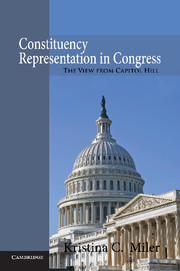Book contents
- Frontmatter
- Contents
- Acknowledgments
- 1 The Unanswered Question of Legislative Perceptions
- 2 A Dyadic Theory of Subconstituency Representation
- 3 The Psychology of Constituency Representation
- 4 Subconstituents Relevant to Health Policy and Natural Resources Policy
- 5 Explaining Legislative Perceptions
- 6 The Effects of Legislative Perception on Participation
- 7 Reassembling the District as a Whole
- 8 Perception, Reform, and Representation in Congress
- Appendix A Sampling
- Appendix B Interviews
- Appendix C Measurement of Primary Independent Variables
- Appendix D Measurement of Legislative Participation
- Appendix E Instrumental Variables Model of Legislative Participation
- References
- Index
3 - The Psychology of Constituency Representation
Published online by Cambridge University Press: 05 October 2010
- Frontmatter
- Contents
- Acknowledgments
- 1 The Unanswered Question of Legislative Perceptions
- 2 A Dyadic Theory of Subconstituency Representation
- 3 The Psychology of Constituency Representation
- 4 Subconstituents Relevant to Health Policy and Natural Resources Policy
- 5 Explaining Legislative Perceptions
- 6 The Effects of Legislative Perception on Participation
- 7 Reassembling the District as a Whole
- 8 Perception, Reform, and Representation in Congress
- Appendix A Sampling
- Appendix B Interviews
- Appendix C Measurement of Primary Independent Variables
- Appendix D Measurement of Legislative Participation
- Appendix E Instrumental Variables Model of Legislative Participation
- References
- Index
Summary
Legislative perceptions of constituents are a fundamental component of political representation because legislators represent the district they see. In order to understand legislative behavior, therefore, it is essential to see the constituency through the eyes of the legislative enterprise. Despite the early consensus on the importance of legislative perceptions (e.g., Dexter 1957; Fenno 1978; Kingdon 1967; Miller and Stokes 1963), political scientists' understanding of how perception affects congressional representation has been limited by the lack of a theory of perception. With no explicit model of the process by which legislative perceptions of the district are formed, questions about which subconstituencies are more or less likely to be perceived by legislative offices – and the impact of these patterns on congressional representation – remain unanswered.
Two important developments offer new insights into the cognitive processes that shape how legislators perceive the constituents in their district. The first of these developments is the growth of research on social cognition in the psychology literature, particularly individuals' use of heuristics, or mental shortcuts, to simplify complex environments. The cognitive psychology literature offers an information-based approach to individuals' perceptions of the world around them that emphasizes how individuals use information, including their reliance on the accessibility heuristic. The second, related, development is the growth of political psychology within the political science discipline, especially research on citizens' use of information in political judgments.
- Type
- Chapter
- Information
- Constituency Representation in CongressThe View from Capitol Hill, pp. 30 - 45Publisher: Cambridge University PressPrint publication year: 2010



